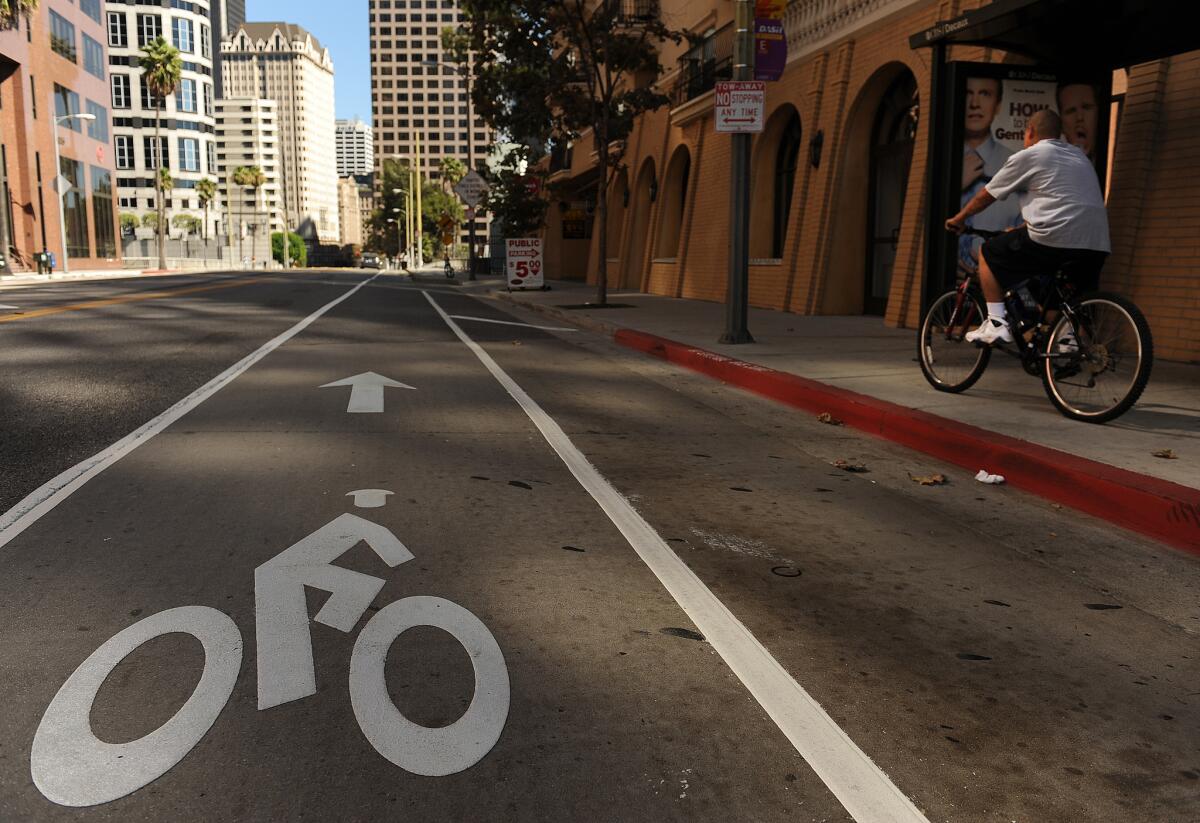Will cyclists get a 3-foot cushion from cars? Only Gov. Brown knows

- Share via
Will the fifth time be the charm for the three-foot rule?
Among the hundreds of bills on Gov. Jerry Brown’s desk is AB 1371, which would require a driver to keep at least three feet of space between his or her car and a bicycle when passing. If the governor signs it, the bill would affect all motor vehicles and bicycles sharing the road in California, but it would have special significance for Los Angeles.
This city -- long regarded as the nation’s most car-loving, driver-centric, petroleum-fueled, bike-hating municipality -- is sponsoring the bill. It’s part of L.A.’s long-simmering but suddenly swooning romance with the bike, nurtured over the last decade by cycling enthusiasts but perhaps brought into full bloom on July 17, 2010, when then-Mayor Antonio Villaraigosa, riding his mountain bike on Venice Boulevard, was cut off by a taxi driver. He crashed, broke his elbow -- and became a champion of the city’s burgeoning bike culture.
By then, two bills that would have required motorists to leave at least three feet between their cars and cyclists had already died in the Legislature. AB 1941 by Democrat Pedro Nava of Santa Barbara failed to get out of the Assembly Transportation Committee in 2006, and Nava’s AB 60 met the same fate in 2008.
After the mayoral crash, Democrat Alan Lowenthal of Long Beach, a state senator who has since moved on to Congress, authored SB 910 in 2011 (see this bill comparison from the California Bicycle Coalition); it would have required the three-foot distance where possible, and otherwise would have required cars to slow to 15 miles per hour when passing.
Lowenthal’s bill got through the Legislature, but Brown vetoed it. The governor noted that California already required a “safe and reasonable” distance, but he had no problem with nailing down the minimum to three feet. It was the reduced speed that troubled him. Or, rather, that troubled the California Highway Patrol and Caltrans. They told the governor that slowing for a bike could cause other cars to rear-end the driver who was dutifully braking, or that one cyclist could cause an entire line of cars to have to slow down. And in case you were wondering, yes, Brown made it clear that such decelerating would be bad thing.
Brown also vetoed last year’s SB 1464, also by Lowenthal, even though the slowing provision was removed. In his veto message, the governor again cited Caltrans, which this time expressed concern that the bill allowed cars to move to the left -- over the double-yellow line, if necessary -- to keep the three-foot minimum distance from cyclists. Allowing cars to violate the sacrosanct divider and, perhaps, stray into oncoming traffic could make the state liable in case of a head-on collision, the governor wrote.
So here we are. Nava and Lowenthal and their four bills are gone, and now Assemblyman Steven Bradford (D-Gardena) is carrying the latest version. The new Three Feet for Safety Act requires drivers who can’t keep their distance to pass at a “reasonable and prudent” speed, but the reference to 15 miles per hour is gone; so is the part about the double-yellow line. The law would take effect a year from Monday, to give everyone time to get used to the idea. Violations could result in a $35 “base fine” -- that means before various surcharges and fees are added. Actually hitting a cyclist and causing bodily injury would result in a fine of $220.
Plus, those rooting for cyclists might add, one heck of a lawsuit. Hundreds of cyclists are hit by cars annually in Los Angeles alone.
If you are, as they say, on the driver’s side in the ongoing encounter, or debate -- or cold war -- between cars and bikes in this motorist-oriented city, you may find yourself wondering whether such a law is necessary. Or wonder what happens when it’s a cyclist who veers too close, or who cuts off a car in traffic.
It’s worth noting, then, that one of the enthusiastic supporters of this bill, along with the city and cycling advocates, is the Automobile Club of Southern California.
We’ll know by Oct. 13, the deadline for signing bills, whether Brown is with them or against them.
ALSO:
Seeing red over a green bike lane
Toning down the Spring Green bike lane
More to Read
A cure for the common opinion
Get thought-provoking perspectives with our weekly newsletter.
You may occasionally receive promotional content from the Los Angeles Times.







